Casual dining is a common term in the food and beverage industry that refers to one of today’s most popular restaurant models. So, what is casual dining? Let’s explore the definition of casual dining and learn more about the difference between casual dining and other dining options with Long Phuong Porcelain.
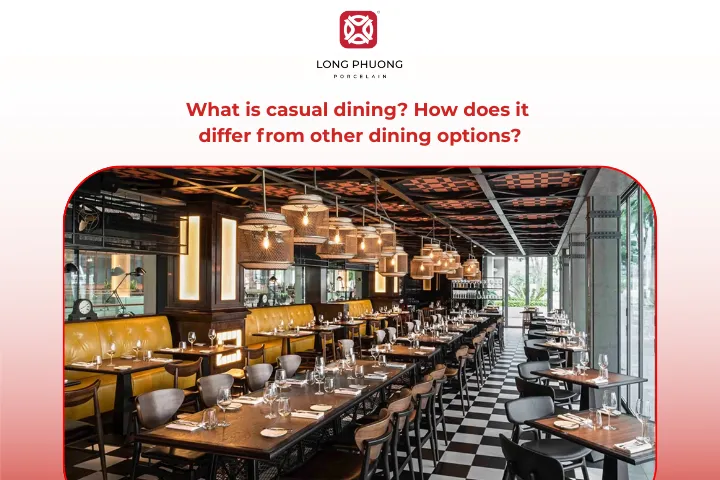
1. Understand the meaning of casual dining
What is casual dining? At its core, casual dining is a restaurant segment positioned between fast food and fine dining. It offers full table service, a laid-back vibe, and a wide variety of dishes at prices that don’t break the bank. These restaurants focus on comfort and convenience, attracting both families and solo diners who want a good meal without the high cost or formality of fine dining.
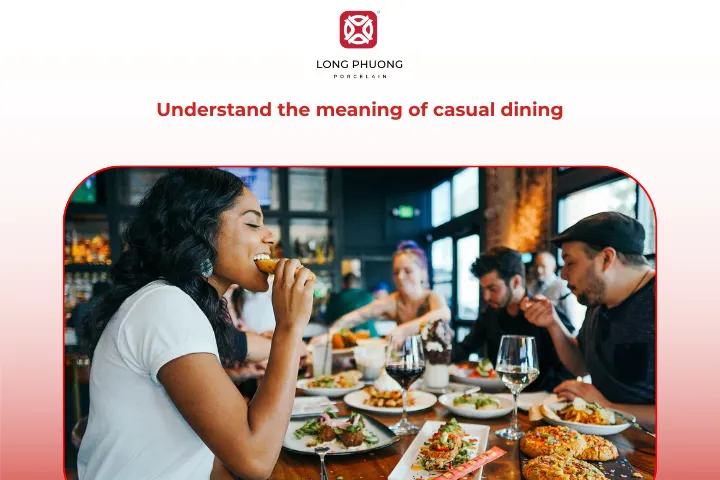
Xem thêm: what is a banquet and how it differs from regular dining
2. The history of the casual dining definition
To truly understand “What is casual dining?”, it helps to look at its history. The definition of casual dining emerged in the mid-20th century, when restaurants started moving away from the stiff formality of fine dining toward a more relaxed and friendly atmosphere. This change came as society evolved, with new cultural values and lifestyles shaping how people wanted to eat and socialize.
At the same time, improvements in food production and transportation made it easier to offer diverse and accessible menus. The growing middle class also played a big role, fueling the demand for dining experiences that were affordable, convenient, and still offered great quality.
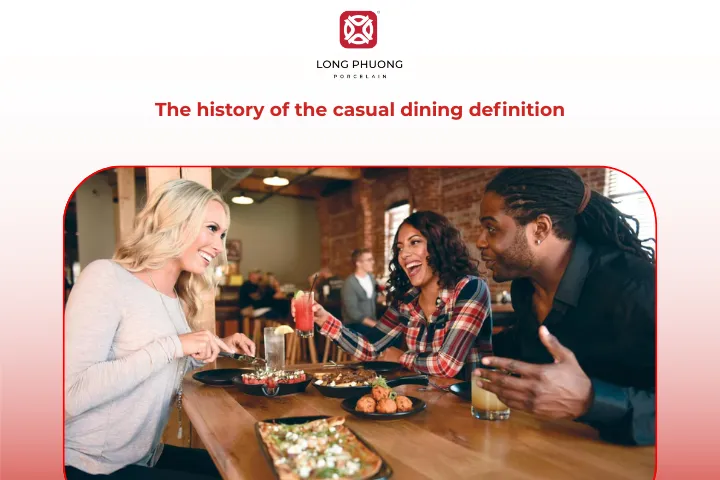
3. Characteristics of casual dining
To get a clearer picture of the answer to the question “What is casual dining?”, let’s look at the main features that set it apart:
- Table service: Unlike fast-food spots, casual dining restaurants have servers who take your order and bring your food to the table. This makes the experience feel more personal and relaxed.
- Comfortable atmosphere: These places focus on being welcoming rather than formal. You’ll find cozy seating, moderate background noise, and simple, inviting décor that encourages guests to unwind.
- Varied menu: Casual dining menus usually include a broad mix of dishes, from appetizers, main courses, to desserts and drinks, offering something for everyone.
- Reasonable prices: Meals typically cost more than fast food but far less than fine dining. The goal is to deliver quality and satisfaction without stretching your budget.
- Familiar flavors: While some restaurants add creative twists, most highlight comfort foods people know and love, like burgers, pasta, sandwiches, and salads.
- Full-service bar (often): Many casual dining places include a bar serving beer, wine, and cocktails, adding a social element that enhances the overall experience.

4. What are the differences between fine dining, fine casual dining, and casual dining?
Understanding “What is casual dining?” helps highlight how it differs from fine dining or fine casual dining. While fine dining focuses on elegance and formality, fine casual dining blends quality with convenience, and casual dining prioritizes comfort and affordability. Here’s how they compare:
| Criteria | Fine dining | Fine casual dining | Casual dining |
| Atmosphere | Elegant, formal setting with upscale décor and quiet ambiance | Stylish yet relaxed setting with a modern, approachable vibe | Comfortable and family-friendly environment |
| Service style | Full table service from a large, well-trained staff providing professional and detailed attention | Quick yet polished service; guests may order at the counter, but enjoy food served at the table | Traditional table service by friendly, informal waitstaff |
| Menu and food quality | Gourmet dishes prepared by professional chefs using premium ingredients and artistic presentation | Chef-driven menu with high-quality dishes served faster and in a casual setting | Familiar comfort foods such as burgers, pasta, and salads made with fresh ingredients |
| Pricing | High-end; reflects premium ingredients, trained staff, and luxurious atmosphere | Moderate to high; offers excellent food at a faster pace and more affordable price | Moderate; higher than fast food but affordable for everyday dining |
| Dress code | Formal or semi-formal attire required | Casual attire acceptable; no formal requirements | Completely casual; guests can dress comfortably |
| Dining duration | Longer, multi-course experience | Quicker dining experience with gourmet-quality food | Moderate pace; suitable for casual meals and gatherings |
| Target audience | Guests seeking a luxurious, formal dining experience | Diners looking for quality food without the formality | Families, friends, and individuals wanting good food in a relaxed setting |
| Reservation policy | Usually required or recommended | Optional, depending on location | Often walk-in friendly |
| Beverage options | Extensive wine and cocktail selection, sometimes with a sommelier | Full bar or curated drink list | Beer, wine, and cocktails are available at most locations |
| Examples | Noma, Geranium, Central, Disfrutar, Pujol | Shake Shack (Danny Meyer concept), Capital Grille, Morton’s The Steakhouse | Olive Garden, Applebee’s, Red Lobster, TGI Fridays, Outback Steakhouse |
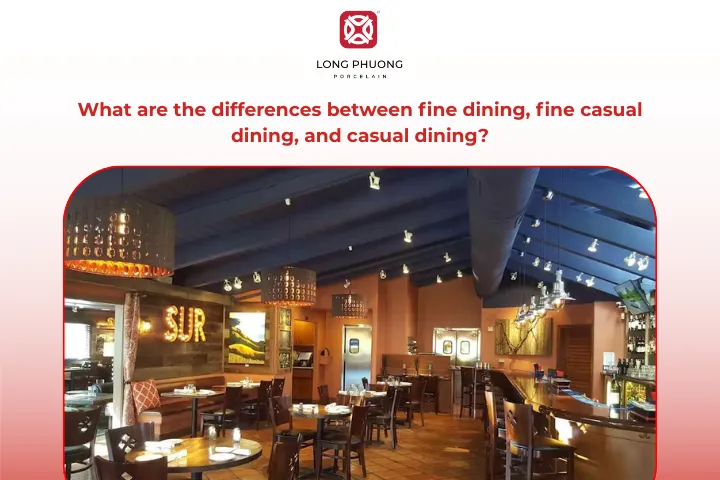
5. How to set up a casual dining table
5.1 Key principles for setting a casual dining table
When setting up a casual dining table or any dining setup, restaurant owners should keep these key principles in mind:
- All tableware must be clean, odor-free, and free from chips or cracks.
- Arrange everything neatly, using only the items that fit the menu.
- Tableware should be placed in the correct order for a proper dining sequence, from appetizers to main courses.
- Napkins should be folded uniformly in one consistent style.
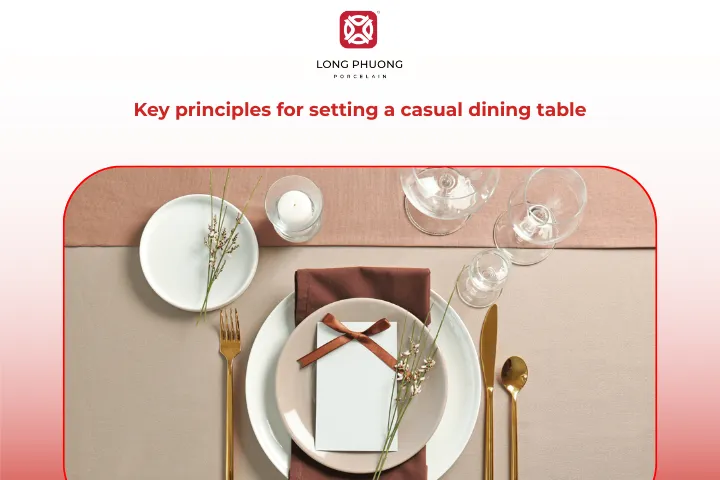
5.2 Step-by-step guide to setting a casual dining table
- The service plate (also called a charger) is the largest plate and should be placed directly in front of the guest’s seat as the base. The dinner plate is then placed on top.
- The bread plate is positioned to the left, with the bread knife’s edge facing downward and toward the table’s edge.
- The napkin is placed on the top plate. It can be folded or rolled according to the restaurant’s style.
- Glasses are set above and to the right of the plates, about half an inch away from the main utensils. Additional glasses are arranged diagonally at about a 45-degree angle from the first.
- Chopsticks and spoons are placed on their rests, about three-quarters of an inch apart.
- Condiment containers, toothpicks, and decorative flower vases should be placed at the center of the table.
- Knives go on the right side, while forks are placed on the left.
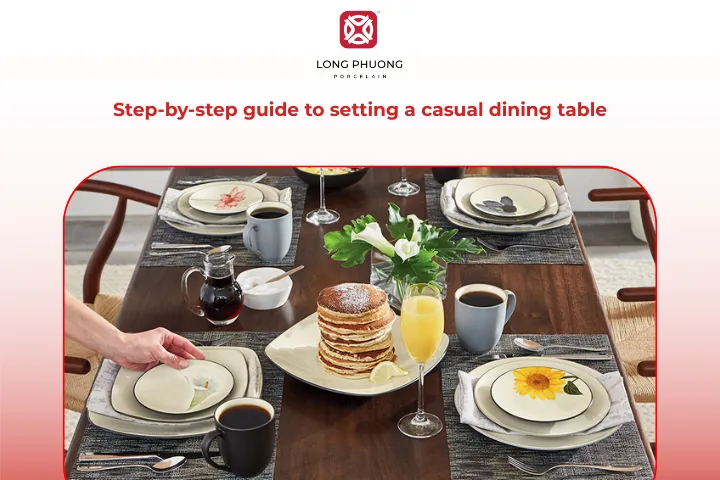
See more: 10+ best dining room place settings ideas for every occasion
6. Advantages and challenges of casual dining
After understanding “What is casual dining?”, you might be curious about the advantages and challenges of this popular restaurant style. Let’s break it down and see why casual dining attracts so many diners, while also exploring the unique challenges it faces in today’s competitive market.
| Advantages | Challenges |
| Affordable quality meals: Casual dining offers tasty, freshly prepared food at reasonable prices. Diners get restaurant-quality dishes without paying fine dining rates. | Competition from fast-casual and delivery services: Fast-casual chains and delivery platforms have raised the bar for convenience, forcing casual dining restaurants to adapt or risk losing customers. |
| Relaxed environment for friends and families: These restaurants create a cozy, welcoming atmosphere that’s perfect for social gatherings, family dinners, or casual celebrations. | Maintaining quality and service consistency: With diverse menus and busy peak hours, keeping food quality and service standards consistent can be a daily challenge. |
| Opportunity for experimentation with food trends: Casual dining restaurants often explore creative menus, seasonal dishes, and global flavors, offering diners something new without the high cost. | Adapting to changing consumer preferences: Diners today want healthier, more sustainable options. Restaurants must evolve quickly to meet these modern demands while staying true to their brand identity. |
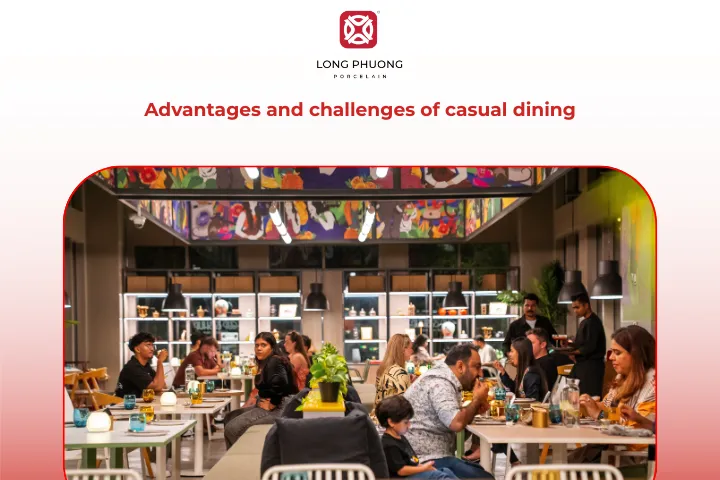
7. Long Phuong Porcelain: A trusted tableware supplier for casual dining restaurants
Long Phuong Porcelain specializes in producing and supplying high-quality tableware for restaurants and hotels domestically and internationally. All Long Phuong products undergo regular quality inspections to ensure they are free from lead, cadmium, heavy metal residues, and are completely safe for users’ health.
Our product range is diverse and practical, with over 500 designs tailored to meet the needs of various restaurant styles, especially casual dining establishments. Long Phuong porcelain tableware not only enhances the visual appeal of each dish and preserves its authentic flavor but also brings a sense of warmth and comfort to any casual dining space.
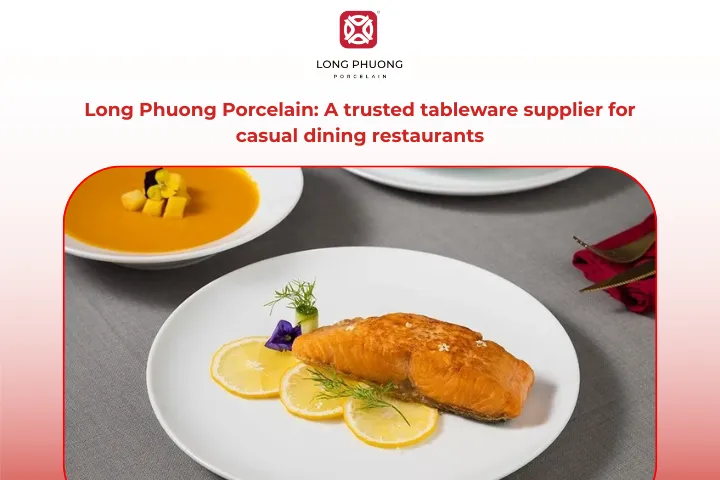
8. Frequently asked questions about casual dining
8.1. What is an example of casual dining?
Some of the most well-known casual dining restaurants include chains like Applebee’s, Olive Garden, Chili’s, and TGI Fridays. These places offer full table service, comfortable seating, and diverse menus with everything from burgers and pasta to salads and desserts. They’re perfect for a relaxed lunch, family dinner, or night out with friends.
8.2. What’s the difference between casual dining and fine dining?
The biggest difference comes down to price, atmosphere, and formality. Fine dining restaurants are elegant, with multi-course meals, upscale décor, and higher prices. Casual dining, on the other hand, is much more laid-back and affordable, while still offering good food and friendly service.
8.3. What’s the difference between casual dining and fast casual dining?
Fast-casual dining fills the space between fast food and casual dining. Both are more relaxed than traditional fast food, but fast-casual typically means you order at the counter and pick up your meal yourself, with only occasional table service. Casual dining, on the other hand, always offers full table service, where guests are seated and attended to by waitstaff.
8.4. What is considered a casual dining restaurant?
A casual dining restaurant typically provides table service, a relaxed atmosphere, and a moderately priced menu. You can expect servers to take your order at the table, in a comfortable setting that’s not overly formal, and a wide selection of dishes suitable for different tastes. It’s a “come-as-you-are” kind of dining experience.
8.5. Is casual dining suitable for families with kids?
Absolutely! Most casual dining restaurants are family-friendly. They often have kids’ menus, booster seats, and flexible options to keep little ones happy. The relaxed setting also means parents don’t have to worry too much about formal etiquette, making it a stress-free dining choice for families.
8.6. How much should I expect to spend at a casual dining restaurant?
Prices can differ based on the restaurant and its location, but on average, diners typically spend between $15 and $30 per person for a main course, not including drinks or appetizers. It’s more than fast food but significantly less than a fine dining experience, making it a great value for the quality and service you receive.
8.7. What types of cuisine are commonly found in casual dining restaurants?
Casual dining restaurants usually feature a broad selection of cuisines, from American and Italian to Mexican and Asian-inspired options. Their menus focus on classic crowd-pleasers like burgers, pasta, sandwiches, and salads, giving diners plenty of comforting choices.
8.8. Are reservations required at casual dining restaurants?
Most casual dining restaurants don’t require reservations, but it’s a good idea to make one during busy times or if you’re dining with a large group. Some places may even reserve tables only for specific group sizes or special occasions.
9. Conclusion
Above, Long Phuong Porcelain has answered the question “What is casual dining?” and the key facts surrounding this model. Casual dining has firmly established itself as a key part of the restaurant world. Understanding the meaning of casual dining helps highlight why it remains so important. As dining trends continue to shift, casual dining is expected to stay relevant and in demand, shaped by evolving customer tastes and habits. Restaurants that adapt quickly and keep meeting these changing expectations will continue to grow and succeed in an ever-competitive market.
Related Articles
CEO of Long Phuong Group Joint Stock Company, with more than 20 years of exploration and research to obtain the best formulas and professional experience, Long Phuong Porcelain has produced more than 400 designs of all kinds of household porcelain, Significant contributions to Vietnam's ceramic industry.
 Vietnam
Vietnam
